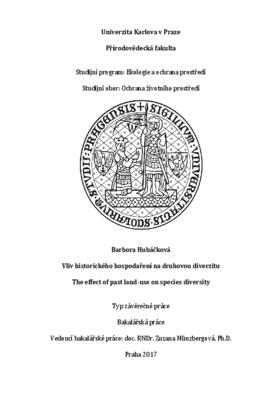Vliv historického hospodaření na druhovou diversitu
The effect of past land-use on species diversity
bakalářská práce (OBHÁJENO)

Zobrazit/
Trvalý odkaz
http://hdl.handle.net/20.500.11956/85762Identifikátory
SIS: 184703
Kolekce
- Kvalifikační práce [21483]
Autor
Vedoucí práce
Oponent práce
Chýlová, Tereza
Fakulta / součást
Přírodovědecká fakulta
Obor
Ochrana životního prostředí
Katedra / ústav / klinika
Ústav pro životní prostředí
Datum obhajoby
12. 6. 2017
Nakladatel
Univerzita Karlova, Přírodovědecká fakultaJazyk
Čeština
Známka
Dobře
Klíčová slova (česky)
polopřírodní travnaté plochy, historický management, biodiverzita, vliv hospodaření, sekundární sukceseKlíčová slova (anglicky)
seminatural grasslands, historical management, biodiversity, past land-use changes, secondary successionTato práce je rešerší vědeckých studií, článků a knih týkajících se vlivu dlouhodobého hospodaření člověka na druhovou diverzitu rostlin. Cílem je shrnutí dosavadních poznatků o vlivu historického managementu na rostlinná společenstva a druhovou bohatost travinných společenstev. Ty jsou člověkem silně ovlivněny a využívány od počátků zemědělství před 8 000 lety. V nedávné době došlo k intenzifikaci zemědělství, výroba se koncentrovala a hůře dostupné oblasti byly opuštěny. Mnoho studií se zabývá sukcesními procesy na opuštěných plochách a souvislostmi mezi druhovou skladbou a historickým managementem. Z jejich výsledků vyplývá, že druhové složení vegetace je spíše determinováno kontinuitou stanoviště než současným způsobem obhospodařování. V poslední kapitole je představena oblast Bílých Karpat, kde bude probíhat terénní výzkum. Klíčová slova: polopřírodní travnaté plochy, historický management, biodiverzita, vliv hospodaření, sekundární sukcese
This thesis is review of scientific studies on the effect of past land-use on species diversity. The aim of the thesis is to summarise knowledge of past land-use changes and their impact on plant communities and species diversity of grasslands. Those are mostly affected by human activities and have been used already for more than 8 000 years. In recent time, the agriculture has intensified, the main production is concentrated and marginal areas are abandoned. Many studies focus on spontaneous succession on these abandoned areas and the relationship between species diversity and past land-use. Their results suggest that current vegetation composition is mostly determined by habitat continuity rather than by recent land-use. In the last part of the thesis, I introduce the area of White Carpathian Mountains where my future research will be held. Key words: seminatural grasslands, historical management, biodiversity, past land-use changes, secondary succession
